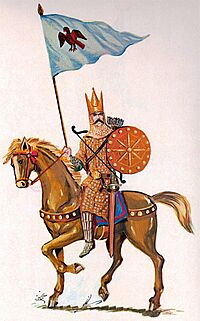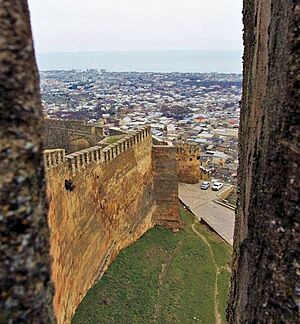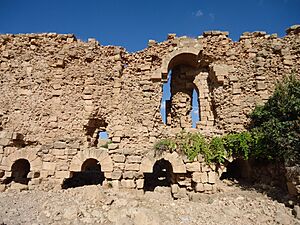Kavad I facts for kids
Quick facts for kids
|
|
|---|---|
| King of Kings of Iran and non-Iran | |
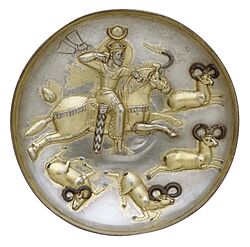
Plate of a Sasanian king hunting rams, perhaps Kavad I
|
|
| King of the Sasanian Empire | |
| 1st reign | 488–496 |
| Predecessor | Balash |
| Successor | Jamasp |
| 2nd reign | 498/9–531 |
| Predecessor | Jamasp |
| Successor | Khosrow I |
| Born | 473 |
| Died | 13 September 531 (aged 57–58) |
| Spouse |
|
| Issue |
|
| House | House of Sasan |
| Father | Peroz I |
| Religion | Zoroastrianism |
Kavad I (Middle Persian: 𐭪𐭥𐭠𐭲 Kawād; 473 – 13 September 531) was a powerful Sasanian ruler. He was the "King of Kings" of Iran from 488 to 531. There was a short break in his rule for about two or three years.
Kavad was the son of Peroz I. Important nobles chose him to be king after his uncle, Balash, was removed from power. Balash was not popular. When Kavad became king, the Sasanian Empire was facing many problems. The kings had lost much of their power. Kavad worked hard to fix the empire. He started many changes that his son, Khosrow I, finished later.
Kavad used a religious leader named Mazdak to help him. Mazdak's ideas helped Kavad make changes that reduced the power of the rich nobles and priests. Because of these changes, and because Kavad had a powerful noble named Sukhra executed, Kavad was put in prison. His brother, Jamasp, became king instead. But Kavad escaped with help from his sister and a friend. He fled to the Hephthalite king, who gave him an army. With this army, Kavad got his throne back in 498 or 499.
After getting his throne back, Kavad needed money. He asked the Byzantine Empire for help. The Byzantines used to pay Iran to protect the Caucasus mountains from northern attacks. But the Byzantine emperor, Anastasius I, said no. This made Kavad invade Byzantine lands, starting the Anastasian War. Kavad captured important cities like Theodosiopolis, Martyropolis, and Amida. In 506, the two empires made peace. The Byzantines agreed to pay Kavad to maintain the Caucasus forts. Kavad also fought a long war against the Hephthalites. By 513, he had taken back the region of Greater Khorasan.
In 528, another war, the Iberian War, started between Iran and the Byzantines. This was in what is now eastern Georgia. The Byzantines did not want to accept Khosrow as Kavad's heir. Also, there was a disagreement about Lazica. Kavad's army lost two battles, but the war did not have a clear winner. Both sides lost many soldiers. In 531, Kavad died from an illness while his army was fighting. His son, Khosrow I, became the new king. Khosrow inherited a strong empire, as powerful as the Byzantines.
Kavad I is seen as one of the most successful Sasanian kings. He solved many big problems. An expert on Iran, Nikolaus Schindel, called him "a genius."
Contents
What's in a Name?
Kavad's name comes from an old, legendary Iranian king named Kay Kawad. This shows that the Sasanians were very interested in their ancient history. His name was written as Kabates in Greek. In Chinese, it was Chü-he-to, and in Arabic, Qubādh.
Iran Before Kavad I
Kavad was born in 473. His father was Peroz I, the Sasanian king. The Sasanian family had ruled Iran since 224. Even though Iran had a strong army, it was smaller and poorer than the Roman Empire. The Sasanian kings relied on rich noble families for soldiers. These noble families had a lot of power. They could even decide who became king.
The Sasanian Empire also faced threats from groups called Huns in the northeast. Kavad's grandfather, Yazdegerd II, fought them. But later, the Huns, especially the Hephthalites, became very strong. Kavad's father, Peroz, was defeated and captured twice by the Hephthalites. The second time, he had to send Kavad as a hostage until he could pay a huge ransom. In 484, Peroz fought the Hephthalites again. He was defeated and killed. His army was destroyed. Many eastern cities of Iran fell under Hephthalite control.
After Peroz's death, a powerful noble named Sukhra helped stop the Hephthalites. He then helped Peroz's brother, Balash, become king. But Balash was not popular. After only four years, the nobles and priests removed him. Sukhra then made Kavad the new king of Iran.
Kavad's First Time as King
Becoming King and Empire's Problems

Kavad became king in 488 when he was just 15 years old. His coins show him as a young man. The empire was in a very bad state. The nobles and priests had too much power. They could even choose who would be king. The economy was also suffering from droughts, hunger, and defeats by the Hephthalites. The Hephthalites had taken over large parts of eastern Iran. They also forced Iran to pay them a lot of money, which emptied the royal treasury. There were also rebellions in western areas like Armenia and Iberia. The common people were also unhappy with the rich elite.
Power Struggle with Sukhra
For the first five years, Kavad was a young king. Sukhra, the powerful noble, was really in charge. People went to Sukhra for everything, not Kavad. Sukhra controlled the royal money and the army. In 493, Kavad was an adult and wanted to rule on his own. He sent Sukhra away to his hometown. But even from there, Sukhra still had a lot of power. He even boasted about making Kavad king.
Kavad worried that Sukhra might rebel. He wanted to get rid of him. But Sukhra controlled the army. Kavad found help from Shapur of Ray, another powerful noble who disliked Sukhra. Shapur marched to Sukhra's hometown, defeated his forces, and put Sukhra in prison. Sukhra was still seen as too powerful, so Kavad had him executed. This made some nobles unhappy and weakened Kavad's position.
The Mazdakite Movement and Kavad's Removal
After Sukhra's death, a priest named Mazdak got Kavad's attention. Mazdak led a religious group called Mazdakism. This group believed in sharing wealth, women, and property. Modern historians think "sharing women" might have been an exaggeration. It probably meant making marriage rules easier for poor people. Rich families saw this as a way to lose their power and advantages.
Kavad used Mazdak's ideas to reduce the power of the nobles and priests. The king's food stores were given to the poor. Land was shared among common people. Some historians wonder if Mazdak was a real person. They think he might have been made up to take the blame away from Kavad.
Because Kavad supported the Mazdakites and executed Sukhra, the nobles removed him from power in 496. They put his brother, Jamasp, on the throne instead.
Prison, Escape, and Return

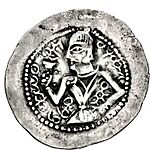
The nobles discussed what to do with Kavad. Some wanted to kill him, but they decided to imprison him instead. Kavad was held in the Castle of Oblivion. According to one story, Kavad's wife helped him. She was allowed to visit him. Kavad swapped clothes with her to look like a woman and escaped. His friend, Siyawush, had horses ready nearby. Another story says Kavad's sister helped him escape by rolling him in a carpet. She told the guard it was dirty with her menstrual blood, so the guard didn't check it.
Kavad fled to the Hephthalite king and found safety there. He even married the Hephthalite king's daughter. In 498 or 499, Kavad returned to Iran with a Hephthalite army. Some Iranian nobles, including a son of Sukhra, supported him. Jamasp and the other nobles did not fight Kavad. They wanted to avoid another civil war. They agreed Kavad would be king again. Kavad spared Jamasp, but he had the nobles who plotted against him executed. Kavad then made his supporters important officials.
Kavad's Second Time as King
Important Changes (Reforms)
Kavad's second rule is famous for his important changes. He could make these changes because the Mazdakites had weakened the power of the nobles and priests. His son, Khosrow I, continued these changes. The defeats by the Hephthalites in the late 400s were a big reason for these reforms.
Kavad changed the tax system. He created a poll tax (a tax on each person). He also checked land to make sure taxes were fair. The empire was divided into four border regions, each with a military commander called a spāhbed. A new office was created to help the poor and needy.
The power of the dehqan, who were small landowners, grew a lot. Some of these dehqans became cavalry soldiers who worked directly for the king. This helped the king rely less on the powerful Parthian noble families for soldiers. Soldiers were also recruited from allies like the Hephthalites and Arabs. These changes made the Sasanian army much stronger. This new army helped Iran win many battles in the future.
Dealing with Mazdak and His Followers
By the 520s, Kavad no longer needed Mazdak. He stopped supporting the Mazdakites. A debate was held where Zoroastrian, Christian, and Jewish leaders spoke against Mazdak. According to the Shahnameh, a famous Persian poem, Kavad sent Mazdak and his followers to Khosrow. Mazdak's supporters were killed, and then Mazdak himself was executed by Khosrow.
Building New Places
Kavad founded or rebuilt many places. He built cities like Eran-asan-kerd-Kawad and Fahraj. He rebuilt Kirmanshah and used it as a home. He also founded a town called Haft-adhar, meaning "seven fires," because of a Zoroastrian fire temple there.
In the Caucasus region, Kavad built new forts at Derbent. He also ordered the building of the Apzut Kawat wall. He fortified the capital of Caucasian Albania, P'artaw, and renamed it Perozkavad. These building projects made the Caucasus a strong point for Iranian power.
Trade with India
Under Kavad, the Sasanians had a lot of control over trade in the region. They used their location in the Persian Gulf to stop Byzantine traders from trading with India. They made deals with Indian kingdoms or attacked Byzantine ships. Iranian traders gained a strong control over the India trade.
War with the Byzantines (Anastasian War)
Iran and the Byzantines had been peaceful for a long time. But war started again in 502. Kavad needed money after his time in prison. He asked the Byzantine Empire for payments. The Byzantines used to pay Iran to protect the Caucasus. But Emperor Anastasius I refused. So, Kavad invaded Byzantine lands.
In 502, Kavad captured Theodosiopolis and Martyropolis. He then attacked the city of Amida. The siege lasted three months, but Kavad's forces finally won. He sent the people of Amida to a new city in southern Iran. The Byzantines tried to take Amida back but failed. In 505, a peace deal was made. The Byzantines paid Iran to maintain the Caucasus forts, and Amida was returned. This war showed Kavad's strength.
Relations with Christians
Kavad's relationship with Christians is not fully clear. In Christian Iberia, he seemed to support Zoroastrianism. But in Armenia, he was peaceful with Christians. Christians in Iran could practice their religion without much trouble. Kavad even supported the leader of the Church of the East. Christians held important jobs in his court.
Some stories say Kavad had a vision of Jesus while attacking Amida. Jesus supposedly promised him the city. This story suggests that Sasanians could be seen as followers of Jesus, even if not Christian.
Wars in the East
Kavad also fought wars in the east. After the Sasanian defeat in 484, the Hephthalites had taken over all of Khorasan. During Kavad's first reign, coins from eastern cities are rare, suggesting Hephthalite control. But during his second reign, things changed. By 512 or 513, Kavad had managed to take back Khorasan from the Hephthalites.
Talks About Khosrow's Adoption
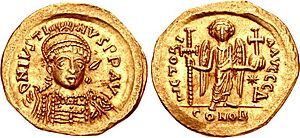
Around 520, Kavad wanted to make sure his youngest son, Khosrow, would become king. Khosrow's position was not safe because of his older brothers. Kavad suggested that the Byzantine emperor Justin I adopt Khosrow. This would make Khosrow's claim to the throne stronger. The Byzantines were interested at first. But some worried that Khosrow might try to take over the Byzantine throne later. They suggested adopting Khosrow as a "barbarian" rather than a Roman. The talks failed. Khosrow felt insulted, and his feelings towards the Byzantines worsened.
A diplomat named Mahbod accused Kavad's friend, Siyawush, of ruining the talks. Siyawush was also accused of following new gods and burying his dead wife, which was against Iranian law. Siyawush was likely a Mazdakite. Even though Siyawush had helped Kavad escape prison, Kavad did not stop his execution. Kavad probably wanted to reduce Siyawush's great power as the head of the army. Siyawush was executed, and his job was removed. Even though the talks failed, a full war did not start until 530.
Iberian War
War between Iran and the Byzantines started again in 528. This was partly because the Byzantines did not accept Khosrow as Kavad's heir. Battles took place in Lazica and Mesopotamia. In 530, a famous battle happened at Dara. The Sasanian army lost badly.
The next year, Kavad sent another army to invade Byzantine lands. The Byzantines won a battle, but Iran also caused heavy losses. In 531, while the Iranian army was attacking Martyropolis, Kavad became ill and died on September 13. The siege was stopped. Kavad's son, Khosrow I, became king. Khosrow then made peace with the Byzantines.
Kavad's Coins

Many of Kavad's coins were made in the provinces of Gorgan, Khuzestan, and Asoristan. His coins show new features. They have symbols like a crescent on his shoulders and a star in the corner. The back of the coin shows a traditional fire altar with two people praying. Kavad used the title kay (meaning "Kayanian") on his coins. This title had been used by his grandfather. Kavad was the last Sasanian king to have kay on his coins. In 504, the phrase abzōn ("may he prosper") was added to his coins.
Who Became King Next?
Before he died, Kavad chose Khosrow to be his successor. Some historians say Kavad crowned Khosrow himself. But when Khosrow became king in 531, some nobles tried to overthrow him. They wanted to make Kavad, the son of Kavad I's second eldest son, king instead. When Khosrow found out, he had all his brothers and their children executed. He also had the nobles involved killed.
Khosrow also ordered the execution of the young Kavad, who was being raised by a noble named Adergoudounbades. But Adergoudounbades did not obey. He secretly raised the child Kavad. Later, Adergoudounbades's own son betrayed him to Khosrow. Khosrow had Adergoudounbades executed. But the young Kavad, or someone pretending to be him, managed to escape to the Byzantine Empire.
Kavad's Lasting Impact
Kavad's time as king was a major turning point for the Sasanian Empire. He successfully dealt with many challenges. He is seen as one of the most effective and successful Sasanian kings. He made his struggling empire strong again. This made it easier for his son, Khosrow I, to take over. Khosrow I made the empire even stronger and became one of Iran's most popular kings.
A later dynasty, the Ziyarids, claimed to be related to Kavad. They ruled parts of Iran between 931 and 1090.
Family Tree
|
King of Kings | |||||||
| Yazdegerd II (438–457) |
|||||||||||||||||||||||||||||||||||||||||||||||||||||||||||||||||||||||
| Hormizd III (457–459) |
Peroz I (457–484) |
Balash (484–488) |
Zarer (d. 485) |
||||||||||||||||||||||||||||||||||||||||||||||||||||||||||||||||||||
| Balendukht | |||||||||||||||||||||||||||||||||||||||||||||||||||||||||||||||||||||||
| Kavad I (488–496, 498/9–531) |
Jamasp (496–498/9) |
Perozdukht | Sambice | ||||||||||||||||||||||||||||||||||||||||||||||||||||||||||||||||||||
| Kawus (d. c. 531) |
Jamasp (d. c. 532) |
Xerxes | Khosrow I (531–579) |
||||||||||||||||||||||||||||||||||||||||||||||||||||||||||||||||||||
Images for kids
-
15th-century Shahnameh illustration of the defeat and death of Peroz I.


